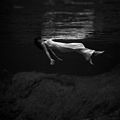Portal:The Arts
The arts or creative arts are a vast range of human practices of creative expression, storytelling, and cultural participation. The arts encompass diverse and plural modes of thinking, doing, and being in an extensive range of media. Both dynamic and a characteristically constant feature of human life have developed into stylized and intricate forms. This is achieved through sustained and deliberate study, training, or theorizing within a particular tradition, generations, and even between civilizations. The arts are a vehicle through which human beings cultivate distinct social, cultural, and individual identities while transmitting values, impressions, judgements, ideas, visions, spiritual meanings, patterns of life, and experiences across time and space. (Full article...)
Featured articles -
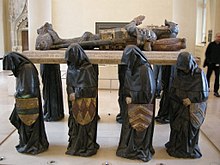
The tomb of Philippe Pot is a life-sized funerary monument, now on display in the Louvre, Paris. It was commissioned by the military leader and diplomat Philippe Pot for his burial at the chapel of Saint-Jean-Baptiste in Cîteaux Abbey, Dijon, France. His effigy shows him recumbent on a slab, his hands raised in prayer, and wearing armour and a heraldic tunic. The eight mourners (pleurants) are dressed in black hoods, and act as pallbearers carrying him towards his grave. Pot commissioned the tomb when he was around 52 years old, some 13 years before his death in 1493. The detailed inscriptions written on the sides of the slab emphasise his achievements and social standing. (Full article...)
The Human Centipede (First Sequence) is a 2009 Dutch independent body horror film written, directed and co-produced by Tom Six. The film concerns a deranged German surgeon who kidnaps three tourists and conjoins them surgically, mouth to anus, forming the eponymous "human centipede". It stars Dieter Laser as Josef Heiter, the creator of the centipede; and Ashley C. Williams, Ashlynn Yennie, and Akihiro Kitamura as Heiter's victims. (Full article...)
The Hitler Diaries (‹See Tfd›German: Hitler-Tagebücher) were a series of sixty volumes of journals purportedly written by Adolf Hitler, but forged by Konrad Kujau between 1981 and 1983. The diaries were purchased in 1983 for 9.3 million Deutsche Marks (£2.3 million or $3.7 million) by the West German news magazine Stern, which sold serialisation rights to several news organisations. One of the publications involved was The Sunday Times, who asked their independent director, the historian Hugh Trevor-Roper, to authenticate the diaries; he did so, pronouncing them genuine. At the press conference to announce the publication, Trevor-Roper announced that on reflection he had changed his mind, and other historians also raised questions concerning their validity. Rigorous forensic analysis, which had not been performed previously, quickly confirmed that the diaries were fakes. (Full article...)
A Song Flung Up to Heaven is the sixth book in author Maya Angelou's series of autobiographies. Set between 1965 and 1968, it begins where Angelou's previous book All God's Children Need Traveling Shoes ends, with Angelou's trip from Accra, Ghana, where she had lived for the past four years, back to the United States. Two "calamitous events" frame the beginning and end of the book—the assassinations of Malcolm X and Martin Luther King Jr. Angelou describes how she dealt with these events and the sweeping changes in both the country and in her personal life, and how she coped with her return home to the U.S. The book ends with Angelou at "the threshold of her literary career", writing the opening lines to her first autobiography, I Know Why the Caged Bird Sings. (Full article...)
Almost There is the first studio album by the American Christian rock band MercyMe. Produced by Pete Kipley, it was released on August 14, 2001, by INO Records. After releasing six albums as an unsigned band, they decided to pursue a record contract because it became too difficult to sell albums, book shows, and manage themselves. The band was assigned to work with Kipley, who had not produced a major project before. Four songs on the album had previously appeared on their self-released albums; the rest were newly recorded songs. Critics have characterized the music on the album as contemporary worship and pop rock, with a more radio-friendly sound than the band's self-released albums. (Full article...)
This Year's Model is the second studio album by the English singer-songwriter Elvis Costello, released on 17 March 1978 through Radar Records. After being backed by Clover for his debut album My Aim Is True (1977), Costello formed the Attractions—keyboardist Steve Nieve, bassist Bruce Thomas and drummer Pete Thomas (no relation)—as his permanent backing band. Recording sessions took place at London's Eden Studios in eleven days between late 1977 and early 1978. Nick Lowe returned as producer, and Roger Béchirian acted as engineer. Most of the songs were written prior to the sessions, and debuted live during the latter half of 1977. (Full article...)
The Soiscél Molaisse (/ˈsiːʃˌkɛl ˌmɒˈlæʃ/ SEESH-kel mo-LASH; 'Gospel of St. Molaisse') is an Irish cumdach (a type of ornamented metal reliquary box or carrying case for a holy book) that originated from an 8th-century wooden core embellished in the 11th and 15th centuries with metal plates decorated in the Insular style. Until the late 18th century, the shrine held a now-lost companion text, presumed to be a small illuminated gospel book associated with Saint Laisrén mac Nad Froích (d. 564 or 571), also known as Molaisse or "Mo Laisse". In the 6th century, Molaisse founded a church on Devenish Island in the southern part of Lough Erne in County Fermanagh, with which the cumdach is associated. (Full article...)
"The Riddle of the Sphinx" is the third episode of the third series of the British dark comedy anthology television programme Inside No. 9. It first aired, on BBC Two, on 28 February 2017. The episode was written by the programme's creators, Steve Pemberton and Reece Shearsmith, and directed by Guillem Morales. "The Riddle of the Sphinx", which is set in Cambridge, stars Alexandra Roach as Nina, a young woman seeking answers to the Varsity cryptic crossword, Pemberton as Professor Nigel Squires, who pseudonymously sets the crossword using the name Sphinx, and Shearsmith as Dr Jacob Tyler, another Cambridge academic. The story begins with Nina surreptitiously entering Squires's rooms on a stormy night and being discovered; this leads to Squires teaching her how to decipher clues in cryptic crosswords. (Full article...)




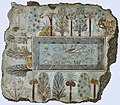






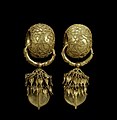
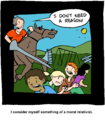








![Image 21Madonna and child at Chiaroscuro], by Bartolomeo Coriolano (edited by Durova) (from Wikipedia:Featured pictures/Artwork/Others)](http://upload.wikimedia.org/wikipedia/commons/thumb/4/49/Mary_Coriolano2.jpg/91px-Mary_Coriolano2.jpg)



















































